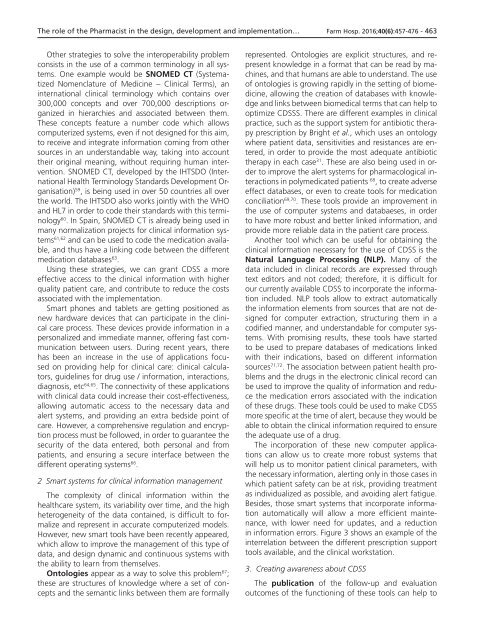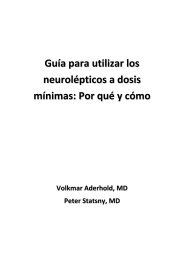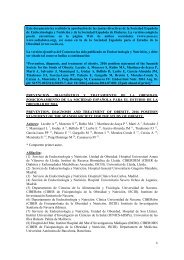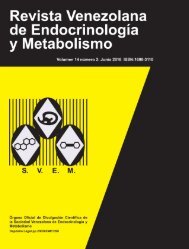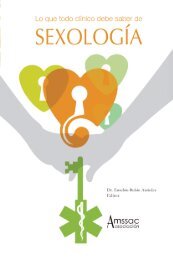Noviembre-Diciembre
156_v40n6(1)
156_v40n6(1)
Create successful ePaper yourself
Turn your PDF publications into a flip-book with our unique Google optimized e-Paper software.
The role of the Pharmacist in the design, development and implementation… Farm Hosp. 2016;40(6):457-476 - 463<br />
Other strategies to solve the interoperability problem<br />
consists in the use of a common terminology in all systems.<br />
One example would be SNOMED CT (Systematized<br />
Nomenclature of Medicine – Clinical Terms), an<br />
international clinical terminology which contains over<br />
300,000 concepts and over 700,000 descriptions organized<br />
in hierarchies and associated between them.<br />
These concepts feature a number code which allows<br />
computerized systems, even if not designed for this aim,<br />
to receive and integrate information coming from other<br />
sources in an understandable way, taking into account<br />
their original meaning, without requiring human intervention.<br />
SNOMED CT, developed by the IHTSDO (International<br />
Health Terminology Standards Development Organisation)<br />
59 , is being used in over 50 countries all over<br />
the world. The IHTSDO also works jointly with the WHO<br />
and HL7 in order to code their standards with this terminology<br />
60 . In Spain, SNOMED CT is already being used in<br />
many normalization projects for clinical information systems<br />
61,62 and can be used to code the medication available,<br />
and thus have a linking code between the different<br />
medication databases 63 .<br />
Using these strategies, we can grant CDSS a more<br />
effective access to the clinical information with higher<br />
quality patient care, and contribute to reduce the costs<br />
associated with the implementation.<br />
Smart phones and tablets are getting positioned as<br />
new hardware devices that can participate in the clinical<br />
care process. These devices provide information in a<br />
personalized and immediate manner, offering fast communication<br />
between users. During recent years, there<br />
has been an increase in the use of applications focused<br />
on providing help for clinical care: clinical calculators,<br />
guidelines for drug use / information, interactions,<br />
diagnosis, etc 64,65 . The connectivity of these applications<br />
with clinical data could increase their cost-effectiveness,<br />
allowing automatic access to the necessary data and<br />
alert systems, and providing an extra bedside point of<br />
care. However, a comprehensive regulation and encryption<br />
process must be followed, in order to guarantee the<br />
security of the data entered, both personal and from<br />
patients, and ensuring a secure interface between the<br />
different operating systems 66 .<br />
2 Smart systems for clinical information management<br />
The complexity of clinical information within the<br />
healthcare system, its variability over time, and the high<br />
heterogeneity of the data contained, is difficult to formalize<br />
and represent in accurate computerized models.<br />
However, new smart tools have been recently appeared,<br />
which allow to improve the management of this type of<br />
data, and design dynamic and continuous systems with<br />
the ability to learn from themselves.<br />
Ontologies appear as a way to solve this problem 67 ;<br />
these are structures of knowledge where a set of concepts<br />
and the semantic links between them are formally<br />
represented. Ontologies are explicit structures, and represent<br />
knowledge in a format that can be read by machines,<br />
and that humans are able to understand. The use<br />
of ontologies is growing rapidly in the setting of biomedicine,<br />
allowing the creation of databases with knowledge<br />
and links between biomedical terms that can help to<br />
optimize CDSSS. There are different examples in clinical<br />
practice, such as the support system for antibiotic therapy<br />
prescription by Bright et al., which uses an ontology<br />
where patient data, sensitivities and resistances are entered,<br />
in order to provide the most adequate antibiotic<br />
therapy in each case 31 . These are also being used in order<br />
to improve the alert systems for pharmacological interactions<br />
in polymedicated patients 68 , to create adverse<br />
effect databases, or even to create tools for medication<br />
conciliation 69,70 . These tools provide an improvement in<br />
the use of computer systems and databaeses, in order<br />
to have more robust and better linked information, and<br />
provide more reliable data in the patient care process.<br />
Another tool which can be useful for obtaining the<br />
clinical information necessary for the use of CDSS is the<br />
Natural Language Processing (NLP). Many of the<br />
data included in clinical records are expressed through<br />
text editors and not coded; therefore, it is difficult for<br />
our currently available CDSS to incorporate the information<br />
included. NLP tools allow to extract automatically<br />
the information elements from sources that are not designed<br />
for computer extraction, structuring them in a<br />
codified manner, and understandable for computer systems.<br />
With promising results, these tools have started<br />
to be used to prepare databases of medications linked<br />
with their indications, based on different information<br />
sources 71,72 . The association between patient health problems<br />
and the drugs in the electronic clinical record can<br />
be used to improve the quality of information and reduce<br />
the medication errors associated with the indication<br />
of these drugs. These tools could be used to make CDSS<br />
more specific at the time of alert, because they would be<br />
able to obtain the clinical information required to ensure<br />
the adequate use of a drug.<br />
The incorporation of these new computer applications<br />
can allow us to create more robust systems that<br />
will help us to monitor patient clinical parameters, with<br />
the necessary information, alerting only in those cases in<br />
which patient safety can be at risk, providing treatment<br />
as individualized as possible, and avoiding alert fatigue.<br />
Besides, those smart systems that incorporate information<br />
automatically will allow a more efficient maintenance,<br />
with lower need for updates, and a reduction<br />
in information errors. Figure 3 shows an example of the<br />
interrelation between the different prescription support<br />
tools available, and the clinical workstation.<br />
3. Creating awareness about CDSS<br />
The publication of the follow-up and evaluation<br />
outcomes of the functioning of these tools can help to


